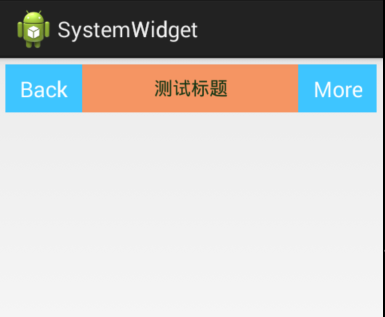具有重用功能的控件集合,例如一些app有一些共同的UI界面,例如标题栏,通常情况下会被抽象出来,形成一个共同的UI界面
1、为一个View提供自己的属性
在res/values下创建attrs.xml属性定义文件
< declare-styleable>标签声明使用自定义属性,name属性来确定引用的名称,format来指定属性的类型,是字符串还是颜色还是资源啥的
<?xml version="1.0" encoding="utf-8"?>
<resources>
<declare-styleable name="TopBar">
<attr name="title" format="string" />
<attr name="titleTextSize" format="dimension" />
<attr name="titleTextColor" format="color" />
<attr name="leftTextColor" format="color" />
<attr name="leftBackground" format="reference|color" />
<attr name="leftText" format="string" />
<attr name="rightTextColor" format="color" />
<attr name="rightBackground" format="reference|color" />
<attr name="rightText" format="string" />
</declare-styleable>
</resources>2、确定好属性后,创建一个自定义的TopBar,继承ViewGroup,这里用RelativeLayout代替
系统提供TypedArray这样的数据结构来获取自定义属性集,在构造方法里获取
import android.content.Context;
import android.content.res.TypedArray;
import android.graphics.drawable.Drawable;
import android.util.AttributeSet;
import android.view.Gravity;
import android.view.View;
import android.widget.Button;
import android.widget.RelativeLayout;
import android.widget.TextView;
public class TopBar extends RelativeLayout {
// 包含topbar上的元素:左按钮、右按钮、标题
private Button mLeftButton, mRightButton;
private TextView mTitleView;
// 布局属性,用来控制组件元素在ViewGroup中的位置
private LayoutParams mLeftParams, mTitlepParams, mRightParams;
// 左按钮的属性值,即我们在atts.xml文件中定义的属性
private int mLeftTextColor;
private Drawable mLeftBackground;
private String mLeftText;
// 右按钮的属性值,即我们在atts.xml文件中定义的属性
private int mRightTextColor;
private Drawable mRightBackground;
private String mRightText;
// 标题的属性值,即我们在atts.xml文件中定义的属性
private float mTitleTextSize;
private int mTitleTextColor;
private String mTitle;
// 映射传入的接口对象
private topbarClickListener mListener;
public TopBar(Context context, AttributeSet attrs, int defStyle) {
super(context, attrs, defStyle);
}
public TopBar(Context context) {
super(context);
}
//////////////////////////////////////////////////////////
public TopBar(Context context, AttributeSet attrs) {
super(context, attrs);
// 设置topbar的背景
setBackgroundColor(0xFFF59563);
// 通过这个方法,将你在atts.xml中定义的declare-styleable
// 的所有属性的值存储到TypedArray中
TypedArray ta = context.obtainStyledAttributes(attrs,
R.styleable.TopBar);
// 从TypedArray中取出对应的值来为要设置的属性赋值
mLeftTextColor = ta.getColor(
R.styleable.TopBar_leftTextColor, 0);
mLeftBackground = ta.getDrawable(
R.styleable.TopBar_leftBackground);
mLeftText = ta.getString(R.styleable.TopBar_leftText);
mRightTextColor = ta.getColor(
R.styleable.TopBar_rightTextColor, 0);
mRightBackground = ta.getDrawable(
R.styleable.TopBar_rightBackground);
mRightText = ta.getString(R.styleable.TopBar_rightText);
mTitleTextSize = ta.getDimension(
R.styleable.TopBar_titleTextSize, 10);
mTitleTextColor = ta.getColor(
R.styleable.TopBar_titleTextColor, 0);
mTitle = ta.getString(R.styleable.TopBar_title);
// 获取完TypedArray的值后,一般要调用
// recyle方法来避免重新创建的时候的错误
ta.recycle();
////////////////////////////////////////////////////////////////
// 3、组合空间,左右俩Button,中间一TextView
mLeftButton = new Button(context);
mRightButton = new Button(context);
mTitleView = new TextView(context);
// 为创建的组件元素赋值
// 值就来源于我们在引用的xml文件中给对应属性的赋值
mLeftButton.setTextColor(mLeftTextColor);
mLeftButton.setBackground(mLeftBackground);
mLeftButton.setText(mLeftText);
mRightButton.setTextColor(mRightTextColor);
mRightButton.setBackground(mRightBackground);
mRightButton.setText(mRightText);
mTitleView.setText(mTitle);
mTitleView.setTextColor(mTitleTextColor);
mTitleView.setTextSize(mTitleTextSize);
mTitleView.setGravity(Gravity.CENTER);
// 为组件元素设置相应的布局元素
mLeftParams = new LayoutParams(
LayoutParams.WRAP_CONTENT,
LayoutParams.MATCH_PARENT);
mLeftParams.addRule(RelativeLayout.ALIGN_PARENT_LEFT, TRUE);
// 添加到ViewGroup
addView(mLeftButton, mLeftParams);
mRightParams = new LayoutParams(
LayoutParams.WRAP_CONTENT,
LayoutParams.MATCH_PARENT);
mRightParams.addRule(RelativeLayout.ALIGN_PARENT_RIGHT, TRUE);
addView(mRightButton, mRightParams);
mTitlepParams = new LayoutParams(
LayoutParams.WRAP_CONTENT,
LayoutParams.MATCH_PARENT);
mTitlepParams.addRule(RelativeLayout.CENTER_IN_PARENT, TRUE);
addView(mTitleView, mTitlepParams);
///////////////////////////////////////////////////////////////
// 5、调用接口的方法
// 按钮的点击事件,不需要具体的实现,
// 只需调用接口的方法,回调的时候,会有具体的实现
mRightButton.setOnClickListener(new OnClickListener() {
@Override
public void onClick(View v) {
mListener.rightClick();
}
});
mLeftButton.setOnClickListener(new OnClickListener() {
@Override
public void onClick(View v) {
mListener.leftClick();
}
});
}
// 暴露一个方法给调用者来注册接口回调,此处为监听器的写法
// 通过接口来获得回调者对接口方法的实现
public void setOnTopbarClickListener(topbarClickListener mListener) {
this.mListener = mListener;
}
///////////////////////////////////////////////////////////
/**
* 6、设置按钮的显示与否 通过id区分按钮,flag区分是否显示
*
* @param id id
* @param flag 是否显示
*/
public void setButtonVisable(int id, boolean flag) {
if (flag) {
if (id == 0) {
mLeftButton.setVisibility(View.VISIBLE);
} else {
mRightButton.setVisibility(View.VISIBLE);
}
} else {
if (id == 0) {
mLeftButton.setVisibility(View.GONE);
} else {
mRightButton.setVisibility(View.GONE);
}
}
}
///////////////////////////////////////////////////////////////
// 4、创建一个接口,暴露给调用者,此处也为监听器的写法
// 接口对象,实现回调机制,在回调方法中
// 通过映射的接口对象调用接口中的方法
// 而不用去考虑如何实现,具体的实现由调用者去创建
public interface topbarClickListener {
// 左按钮点击事件
void leftClick();
// 右按钮点击事件
void rightClick();
}
}
3、引入UI模板
系统属性名字空间:xmlns:android=”http://schemas.android.com/apk/res/android”
自定义控件名字空间,其中取名为custom,之后再XML文件如果使用自定义的属性时就可以通过这个名字来引用:xmlns:custom=”http://schemas.android.com/apk/res-auto”
<com.xys.mytopbar.Topbar xmlns:android="http://schemas.android.com/apk/res/android"
xmlns:custom="http://schemas.android.com/apk/res-auto"
android:id="@+id/topBar"
android:layout_width="match_parent"
android:layout_height="40dp"
custom:leftBackground="@drawable/blue_button"
custom:leftText="Back"
custom:leftTextColor="#FFFFFF"
custom:rightBackground="@drawable/blue_button"
custom:rightText="More"
custom:rightTextColor="#FFFFFF"
custom:title="自定义标题"
custom:titleTextColor="#123412"
custom:titleTextSize="15sp">
</com.xys.mytopbar.Topbar>4、其他类来使用TopBar
页面布局:
<RelativeLayout xmlns:android="http://schemas.android.com/apk/res/android"
//名字空间
xmlns:custom="http://schemas.android.com/apk/res-auto"
xmlns:tools="http://schemas.android.com/tools"
android:layout_width="match_parent"
android:layout_height="match_parent"
android:padding="5dp"
tools:context=".MainActivity">
<!--<include layout="@layout/topbar" /> -->
<com.imooc.systemwidget.TopBar
android:id="@+id/topBar"
android:layout_width="match_parent"
android:layout_height="40dp"
custom:leftBackground="@drawable/blue_button"
custom:leftText="Back"
custom:leftTextColor="#FFFFFF"
custom:rightBackground="@drawable/blue_button"
custom:rightText="More"
custom:rightTextColor="#FFFFFF"
custom:title="测试标题"
custom:titleTextColor="#123412"
custom:titleTextSize="10sp"/>
</RelativeLayout>import android.app.Activity;
import android.os.Bundle;
import android.widget.Toast;
public class TopBarTest extends Activity {
private TopBar mTopbar;
@Override
protected void onCreate(Bundle savedInstanceState) {
super.onCreate(savedInstanceState);
setContentView(R.layout.topbar_test);
// 获得我们创建的topbar
mTopbar = (TopBar) findViewById(R.id.topBar);
// 为topbar注册监听事件,传入定义的接口
// 并以匿名类的方式实现接口内的方法
mTopbar.setOnTopbarClickListener(
new TopBar.topbarClickListener() {
@Override
public void rightClick() {
Toast.makeText(TopBarTest.this,
"right", Toast.LENGTH_SHORT)
.show();
}
@Override
public void leftClick() {
Toast.makeText(TopBarTest.this,
"left", Toast.LENGTH_SHORT)
.show();
}
});
// 控制topbar上组件的状态
mTopbar.setButtonVisable(0, true);
mTopbar.setButtonVisable(1,true );
}
}
标明:以上来自《Android群英传》内容,详解请看书























 2131
2131

 被折叠的 条评论
为什么被折叠?
被折叠的 条评论
为什么被折叠?








